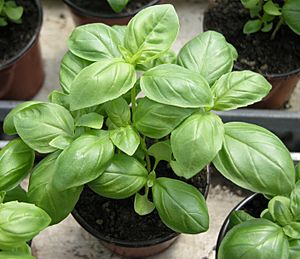Ocimum facts for kids
Quick facts for kids Ocimum |
|
|---|---|
 |
|
| Ocimum basilicum | |
| Scientific classification |
|
| Kingdom: | Plantae |
| Clade: | Tracheophytes |
| Clade: | Angiosperms |
| Clade: | Eudicots |
| Clade: | Asterids |
| Order: | Lamiales |
| Family: | Lamiaceae |
| Subfamily: | Nepetoideae |
| Tribe: | Ocimeae |
| Genus: | Ocimum L. |
| Synonyms | |
|
|
Ocimum is a group of plants that includes many types of herbs and small shrubs. You might know its most famous member: basil! These plants are known for their strong, pleasant smells. They grow naturally in warm parts of the world, especially in Africa. The name Ocimum comes from an ancient Greek word for basil.
The best-known plants in this group are great basil (O. basilicum), which is a popular cooking herb, and tulsi (also called holy basil), which is used in traditional medicine.
Contents
What is Ocimum?
Ocimum plants are part of the Lamiaceae family, which is also known as the mint family. Most of these plants are annuals, meaning they live for only one growing season, or perennials, meaning they live for more than two years. They are found in tropical and warm areas across all six inhabited continents, but most species grow in Africa.
Plants and Their Environment
Ocimum plants are sometimes eaten by the young forms (called larvae) of certain moths and butterflies. For example, the larvae of the Endoclita malabaricus moth use Ocimum species as a food source. This shows how different living things depend on each other in nature.
Types of Ocimum Plants
There are many different kinds of Ocimum plants. Scientists group them together based on their shared features. Here are a few well-known species:
- Ocimum americanum: This plant is found in tropical Africa, India, China, and Southeast Asia.
- Ocimum basilicum: This is the common basil you might use in cooking. It grows in many parts of Asia and has spread to other continents.
- Ocimum campechianum: Also known as Amazonian basil, this plant is common in Florida, Mexico, and Central and South America.
- Ocimum gratissimum: This is often called African basil and is found in Africa, Madagascar, and southern Asia.
- Ocimum kilimandscharicum: Known as Camphor basil, it grows in East Africa and has a strong smell like camphor.
- Ocimum minimum: This smaller basil type is found in India and Sri Lanka.
- Ocimum tenuiflorum: This is Holy basil or tulsi, an important plant in India.
Mixed Ocimum Types
Sometimes, different Ocimum species can mix together to create new types, called hybrids.
- Ocimum × africanum: This is a hybrid found in Africa, Madagascar, and parts of Asia.
- Ocimum × citriodorum: This is also known as Lemon basil. It's a mix of O. americanum and O. basilicum.
- African blue basil: This is a hybrid of Ocimum kilimandscharicum and O. basilicum.
How We Use Ocimum Plants
Many types of basil used in cooking or for decoration come from Ocimum basilicum or are hybrids of different Ocimum species.
- Thai Basil (O. basilicum var. thyrsiflora): This type of basil is very popular in Thai cuisine. It has a strong flavor, a bit like anise, and is used in curries and stir-fries.
- Lemon Basil (Ocimum × citriodorum): This plant is a hybrid known for its fresh lemon flavor. It's often used in cooking to add a citrusy taste.
- Holy Basil or Tulsi (O. tenuiflorum): This is a very special herb in India. It's considered sacred in some religions and is used in teas, traditional healing remedies, and even cosmetics. It's also used in Thai cooking.
- Amazonian Basil (O. campechianum): This South American species is sometimes used in traditional rituals because its smell is believed to help with certain experiences.
- Ocimum centraliafricanum (O. centraliafricanum): This plant is interesting because it can show where copper deposits are hidden in the ground. It's like a natural indicator!
See also
 In Spanish: Ocimum para niños
In Spanish: Ocimum para niños

